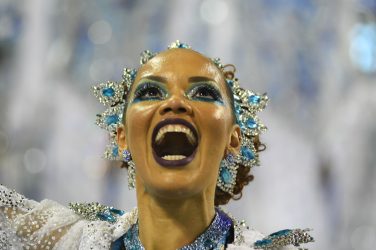 The Ethnicities mural painted by Brazilian graffiti artist Eduardo Kobra at the Olympic Boulevard, located in the port area of Rio, received the certificate from the Guinness World Records Book for the world’s largest graffiti art.
The Ethnicities mural painted by Brazilian graffiti artist Eduardo Kobra at the Olympic Boulevard, located in the port area of Rio, received the certificate from the Guinness World Records Book for the world’s largest graffiti art.
The mural measures an area of almost 3,000 square meters and illustrates the union among the peoples from five continents by showing five faces representing New Guinea’s Huli people, Ethiopia’s Mursi, Thailand’s Kayin, Europe’s Supi and Americas’ Tapajós, responding to the Olympic rings.
Kobra reported that before the certificate was confirmed, the wall had other obstacles to overcome, because of its measures. He said he has not painted the ethnic groups with the intention of holding the title of the world’s largest graffiti art.
“In fact, I had not thought about it. I was aware of the difficulties to paint a mural with these measures, and of everything it means to produce a work like this. It was something I had to overcome,” he said.

- The mural illustrates the union among the peoples from five continents. Fernando Frazão/ABr
For the graffiti artist, social media have mobilized for this title. “They tagged the Guinness Book in several Instagram messages. I think they mobilized and, to my surprise, the mural officially entered the Guinness Book as the world’s largest [mural art]. I was very surprised and honored,” he said.
In addition to its measures, the wall broke another record, not included in the certificate: the number of pictures taken by people who went to the Olympic Boulevard.
The wall became one of the city’s greatest attractions during the Rio 2016 Olympics. “I had painted a mural in New York, that of the kiss, which was among the ten most photographed places in the city, but the number of selfies taken on Ethnicities mural (…) was an unbelievable thing.”
The artist said that he and ten more people have been working for months to complete the composition. “We had a logistics. There were many colors to fill in. Some people to collaborated to it and we manage to produce all this mural,” he said.
He reported that he made more than ten experimental drawings. “It took me three months to get the results of the drawing, then it took me another month preparing the wall, and one more month to paint it,” he explained.
During this period, in addition to rainy days, he had to handle the fierce sun. Besides the intense heat, the sunlight was too strong. “We could not see the colors very well, and the wall was too rustic.”
For Kobra, his work paved the way for other artists invited by Rio’s city hall to paint other murals and walls on old buildings in the port area, changing the look of the place, transforming it into “an open-air art gallery.”
“This wall is a legacy to the city,” he said.
In addition to infrastructure and urban mobility projects, new public leisure areas and urban art in revamped areas of the city became part of the Rio 2016 legacy for local residents and visitors. “Etnias” (“Ethnicities”) was one of those projects.
The mural was officially delivered when the Olympic Torch arrived in Rio on August 4, but the impression it made on passers-by started weeks earlier0.
“This has been a milestone for me, my personal Olympic record — it’s the largest mural I’ve ever painted. I have traveled many cities around the world and it’s such a privilege to do this job here in Rio de Janeiro on such a unique and important occasion,” said the artist, whose works can be found in over 20 countries.
For “Etnias”, Kobra has used more than 3,000 cans of spray paint, about 1,800 liters of latex paint, and 540 liters of enamel paint. He has even used scaffolds and worked as long as eight hours a day along with his assistants.
The city of Rio has also invited other artists to paint murals in the port area of the city. Kobra thinks the initiative will help give visibility to other artists who, like him, came from the city outskirts.
ABr










